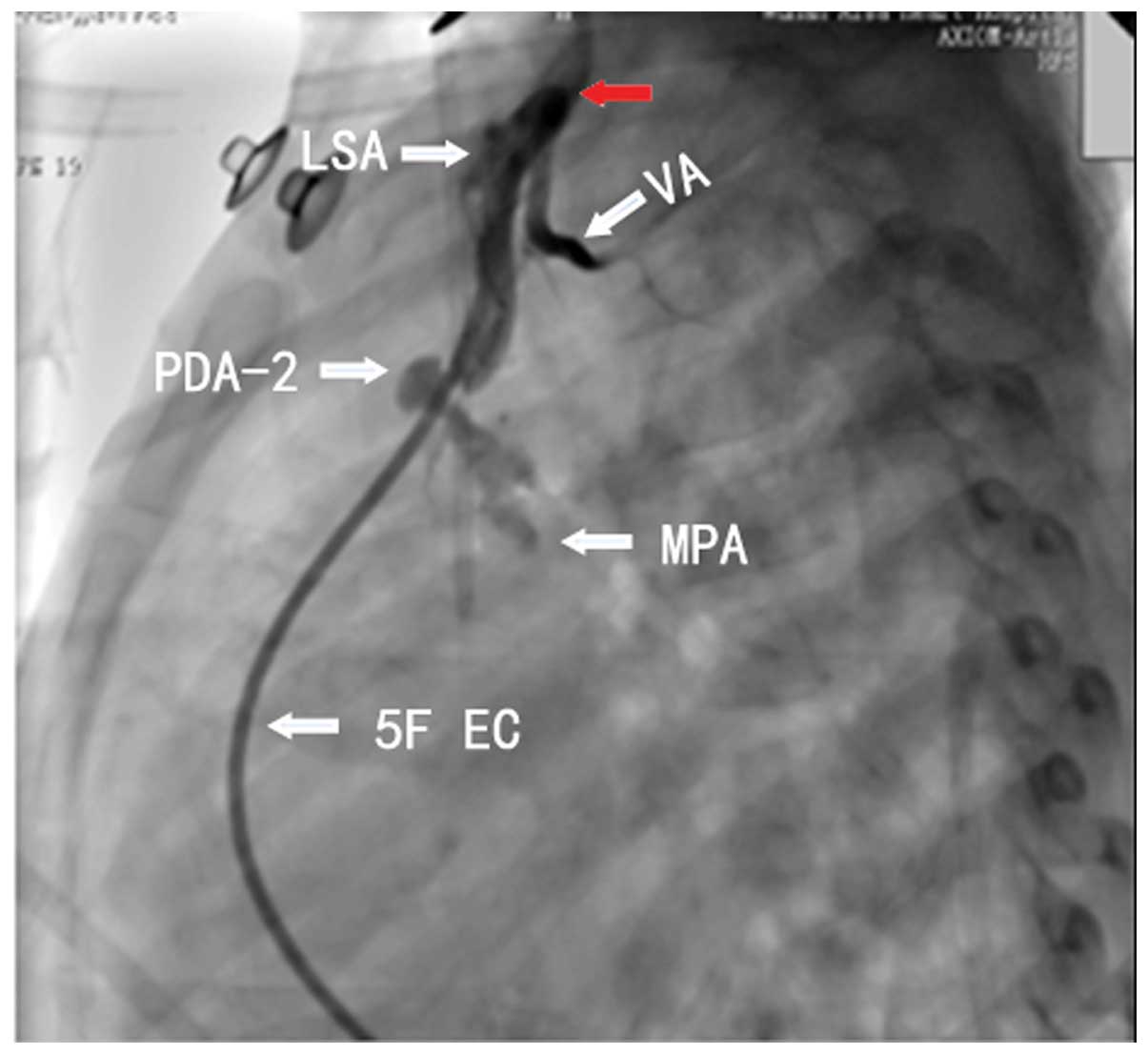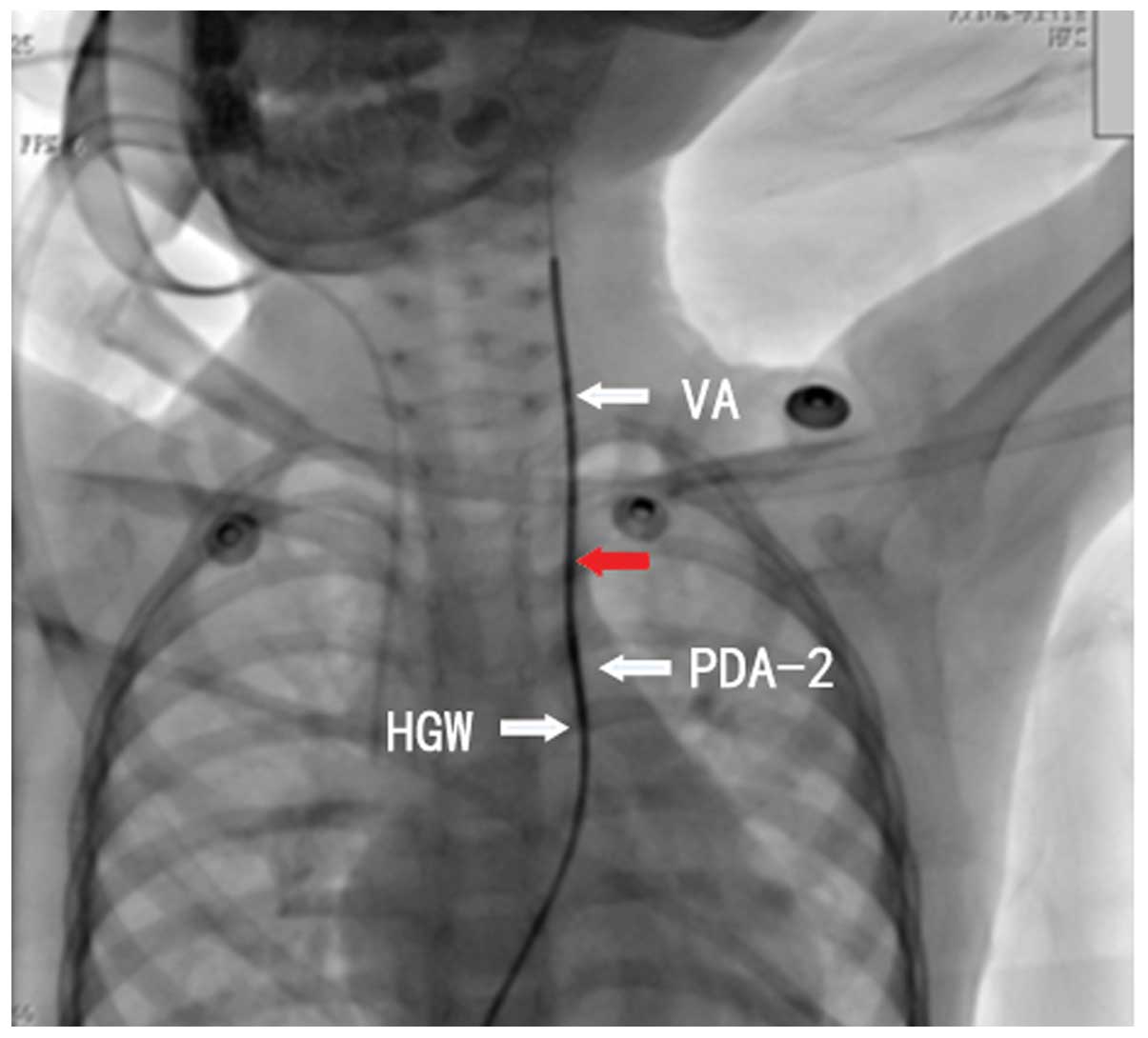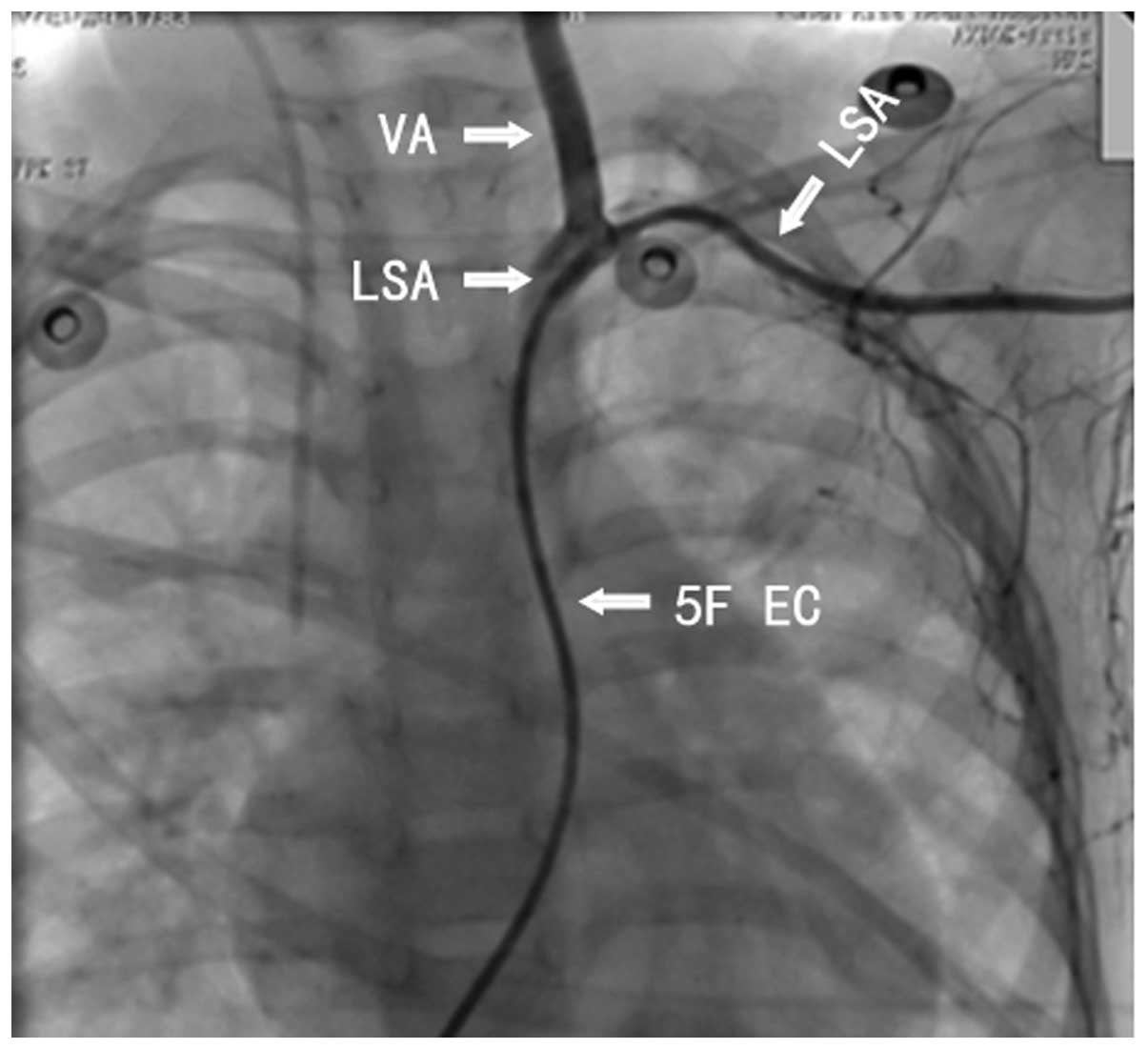Combined interventional and surgical treatment for a rare case of double patent ductus arteriosus
- Authors:
- Published online on: December 8, 2015 https://doi.org/10.3892/etm.2015.2916
- Pages: 510-512
Abstract
Introduction
Patent ductus arteriosus (PDA) is a common congenital heart condition, the incidence of which is 1/2,500–1/5,000 (1). The ductus arteriosus evolves from the sixth left aortic arch in the process of aortic arch development; it is a normal route of blood circulation in the fetus. In normal development, 82–96% of the ductus arteriosus undergoes functional closure within 48 h after birth, and anatomical closure with fibrosis is usually completed in weeks 2–3 after birth (2). Various genetic and/or environmental factors and premature birth may cause arterial tissue elastic fibers to increase, reduce smooth muscle tissue and cause endocardial cushion dysplasia. These factors may lead to the delayed or lack of closure of the PDA. The ductus arteriosus is generally situated at the aortic isthmus and at the left pulmonary artery side of the main pulmonary artery bifurcation. However, in patients with a right aortic arch, it may be located between the aorta distal to the brachiocephalic artery root and the right pulmonary artery. Bilateral ductus arteriosus is very rare (3). This malformation is assumed to occur during the transformation of the branchial-type arterial system to the mammalian-type arterial system in the development of the aorta and its branches (4).
Case report
A 2.5-year-old girl weighing 8.5 kg had a cardiac murmur for >2 years. The pre-hospital echocardiographic diagnosis was congenital heart disease with PDA (funnel-type with left-to-right shunt). The X-ray suggested increased bilateral pulmonary blood; cloud-like high-density shadows were observed in the field of the right lower lung. The cardio-thoracic ratio was 0.57.
Following preoperative preparation, the intent was to perform surgical ligation of the PDA under general anesthesia. A conventional thoracotomy was made at the fourth left intercostal space. The left pulmonary artery was observed to be parallel to the esophagus. The descending aorta was below the esophagus. Freeing the descending aorta was difficult because of obstruction by the esophagus and left pulmonary artery. Considering the poor accessibility, the search for the PDA was abandoned. A drainage tube was placed in the left chest, and the chest was finally closed.
Enhanced computed tomography (CT) of the heart was conducted 2 days after the surgery. The CT images clearly showed the double PDA (Figs. 1 and 2). A 6.6-mm-wide shadow indicated the PDA (PDA-1) in the descending aorta connecting to the right pulmonary artery. The aortic arch was the origin of the left common carotid artery, the right common carotid artery, and the right subclavicular artery. The left subclavian artery originated from the left vertebral artery. The artery was connected to the main pulmonary artery by a duct (PDA-2) 4.5 mm in diameter. The child had situs solitus right-sided aortic arch with right-sided descending aorta, isolated left subclavian artery, and double PDA.
Interventional treatment was conducted in an attempt to block the double PDA. Intraoperative angiography showed the bilateral ductus arteriosus (Figs. 3 and 4). The angiography showed that the narrowest region of the PDA-2 had a diameter of ~2 mm. Establishing a path from PDA-2 to the vertebral artery with the 260-cm hardened guidewire was challenging (Fig. 5). Thus, an attempt was made to establish a path from PDA-2 to the subclavian artery (Fig. 6). However, passing through the twisted PDA-2 was also challenging. Therefore, the closure was abandoned and the surgery was terminated.
Following the interventional surgery, the child was transferred to the surgical operation room for double PDA ligation plus left subclavian artery reconstruction under median thoracotomy. The surgery was successful and after the surgery, the sick child recovered stably.
Discussion
To the best of our knowledge there are no relevant reports about double patent ductus arteriosus. A similar malformation is anomalous origin of the left subclavian artery from the pulmonary artery, which was originally identified at autopsy (5). These abnormalities are divided into two typies. One is aberrant left subclavian artery, the other is the variation of the origin area of subclavian artery. Among them, aberrant left subclavian artery is accounted for 76.2% and the incidence rate is 0.8%. Among these, aberrant left subclavian artery was rarer than aberrant right subclavian artery; from a reported 16 cases of aberrant subclavian artery there was only one case where the left subclavian artery was affected (6). That case reported the concomitant congenital heart disease tetralogy of Fallot, which was very similar to the present case, but differed in that the left subclavian artery arose from the proximal descending aorta and detoured to the rear of the esophagus. It has been reported that cardiovascular malformations may be associated with 22q11.2 deletion (7). Anatomical variations of these vessels have the following clinical implications: i) Compression by the vascular ring may cause a sense of obstruction of the esophagus; ii) the anatomical variations may be associated with congenital heart disease; iii) the variations may be associated with steal syndrome, causing transient cerebral ischemia (8); iv) they may extend the time of examination of neck vessels and the cerebrovascular system by digital subtraction angiography, and increase the incidence of complications; v) the arterial variation should be considered when conducting thoracic surgery to avoid damaging large blood vessels. Double PDA generally indicates the presence of other congenital cardiac defects (9). The main treatment methods for simple PDA include surgery and interventional closure (10). However, studies and treatment experience of double PDA are limited worldwide (11).
The reasons for failed interventional closure of the present case were as follows. i) It was difficult to establish a path to the vertebral artery because the shape of PDA-2 was severely twisted. The soft tip of the hardened guidewire was relatively long. If the hardened portion reached the appropriate site to support the pathway, the soft tip would be forced to enter the vertebrobasilar artery system. ii) When the left subclavian artery was selected for intervention, the soft tip of the hardened guidewire had already reached the farthest point of the left subclavian artery without fully passing through the variant PDA. Thus, the surgery could not be completed. It is hypothesized that shortening the length of the soft head of the hardened guidewire could have enabled the doctor to smoothly complete the establishment of the path. This type of hardened guidewire would require special production.
This unsuccessful interventional treatment was considered very disappointing by the surgeon, who may never again get the opportunity to treat this rare condition. It is hypothesized that the surgery could have been successfully completed if the process had been performed slowly and carefully. Moreover, an operator with good manual dexterity should have performed the insertion of the thread.
References
|
Al-Hamash SM, Wahab HA, Khalid ZH and Nasser IV: Transcatheter closure of patent ductus arteriosus using ADO device, Retrospective study of 149 patients. Heart Views. 13:1–6. 2012. View Article : Google Scholar : PubMed/NCBI | |
|
Wang ZW, Liu WY and Zhang BR: Patent ductus arteriosus. Cardiac Surgery. People's Medical Publishing House. 5862003.(In Chinese). | |
|
Amabile N, Ghez O, Aubert F, Ovaert C, Fraisse A, Kreitmann B and Metras D: Complete correction of interrupted right aortic arch with isolation of left subclavian artery. Ann Thorac Surg. 80:733–735. 2005. View Article : Google Scholar : PubMed/NCBI | |
|
Wang ZW, Liu WY and Zhang BR: Embryonic development of the heart. Cardiac Surgery. People's Medical Publishing House. 18–20. 2003.(In Chinese). | |
|
Guo LN and Jiang Y: The abnorm of figure of aortic arch and right subclavian artery: A case report. Zhong Guo Lin Chuang Jie Pou Xue Za Zhi. 26:5932008.(In Chinese). | |
|
Zhu JQ, Tao XF, Hao NX and Zhang L: CT angiography of variations of subclavian artery. Zhong Guo Yi Xue Jisuan Ji Cheng Xiang Za Zhi. 19:132–135. 2013.(In Chinese). | |
|
Lee ML, Chen M, Tsao LY, Chiu HY, Chiu IS, Yang AD and Tsai PL: Congenital stridor and wheezing as harbingers of the del22q11.2 syndrome presenting cardiovascular malformations of right aortic arch, aberrant left subclavian artery, Kommerell's diverticulum, and left ligamentum arteriosum. Cardiovasc Pathol. 20:124–129. 2011. View Article : Google Scholar : PubMed/NCBI | |
|
Cao YJ, Xiao GD, Zhang CY, Li W and Liu CF: Successful treatment of the left subclavian artery steal syndrome use endovascular stent. Zhong Hua Nao Xue Guan Bing Za Zhi. 4:216–218. 2010.(In Chinese). | |
|
Ugurlucan M, Sayin OA, Dayioglu E and Tireli E: Bilateral PDA in a patient with VSD and pulmonary atresia. J Card Surg. 26:107–110. 2011. View Article : Google Scholar : PubMed/NCBI | |
|
Kulkarni A, Richards J and Duffy D: Survey of management of patent ductus arteriosus in neonatal units across England. Arch Dis Child Fetal Neonatal Ed. 98:465–466. 2013. View Article : Google Scholar | |
|
Zhu XY, Han XM, Zhang YW, Wang ZG, Quan Z, Sheng XT, Jin Y and Deng DA: Catheterization analysis of 133 infants with congenital heart disease. Zhong Guo Shi Yong Er Ke Za Zhi. 17:534–536. 2013.(In Chinese). |















